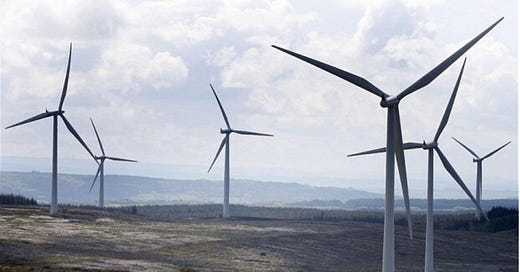"Scotland cuts down 16 million trees to develop wind farms"
Peat bog carbon repositories also being dug up.
By John Leake
In 2014, The Telegraph reported that Millions of trees chopped down to make way for Scottish wind farms. Every year since then, multiple journals have reported that the chopping down of Scotland’s treats and digging up of its (carbon holding) peat bogs has continued unabated. This year’s reporting estimate that the number is now up to 15.7 million trees have been felled to make way for gigantic, ugly, bird-killing, and inefficient wind turbines.
In my attempt to do balanced reporting of this story, I went to the Scottish government’s Forestry and Land management web page, and found the following vague assurance:
How do wind farms and hydro schemes deliver climate change benefits if trees have to be cut down or peat is disturbed?
Decisions on woodland removal and peat disturbance are informed by an Environmental Impact Assessment (EIA). The Scottish Government's Policy on Control of Woodland Removal determines if it is acceptable to remove trees permanently from the land we manage. This then sets the requirement, if any, for compensatory planting.
Wherever appropriate, we will seek to maintain woodland conditions around turbines. This is subject to the impact of tree growth on wildlife, turbine performance and energy yield. The Scottish Government have also published guidance on calculating net carbon impacts on peat. Each development provides these calculations as part of the EIA.
Routine management of forests continues around windfarm developments. This involves felling conifers, followed by replanting of both productive crops and broadleaves, with diversification of the forest to include more open areas.
Ultimately, it is up to the local planning authority, or Scottish Ministers for larger projects, to decide if the removal of trees is an acceptable price to be paid for clean energy.
It is difficult for me to write in an unbiased manner about wind turbine farms because I love forests, birds, and natural landscapes, unmarred by gigantic industrial structures.
The felling of millions of trees reminds me of this poem that Gerard Manley Hopkins wrote about the Binsey Poplars, felled in 1879.
Binsey Poplars
BY GERARD MANLEY HOPKINS
felled 1879
My aspens dear, whose airy cages quelled,
Quelled or quenched in leaves the leaping sun,
All felled, felled, are all felled;
Of a fresh and following folded rank
Not spared, not one
That dandled a sandalled
Shadow that swam or sank
On meadow & river & wind-wandering weed-winding bank.
O if we but knew what we do
When we delve or hew —
Hack and rack the growing green!
Since country is so tender
To touch, her being só slender,
That, like this sleek and seeing ball
But a prick will make no eye at all,
Where we, even where we mean
To mend her we end her,
When we hew or delve:
After-comers cannot guess the beauty been.
Ten or twelve, only ten or twelve
Strokes of havoc unselve
The sweet especial scene,
Rural scene, a rural scene,
Sweet especial rural scene.






What a travesty for Scotland. It was one of most beautiful countries on the map. It was untamed and hills of Heather were breath taking. In the forests you could hear the bagpipes of the ancestors.
Like so much of everything else witnessed today, INSANITY!